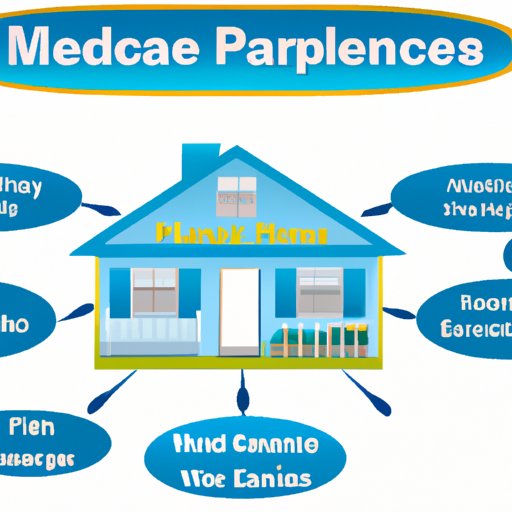Introduction
If you or a loved one has a terminal illness and needs end-of-life care, you may be considering hospice care at home. Medicare provides coverage for some types of hospice care, but it’s important to understand what is covered and what isn’t. This article will provide an overview of what Medicare covers for hospice care at home and give you tips on making the most of your coverage.
What is Medicare-Covered Hospice Care at Home?
Hospice care is a type of palliative care that focuses on providing comfort and support to those with a life-limiting illness. Hospice care can take place in a variety of settings, including the patient’s home, a nursing home, or a hospice facility. Medicare provides coverage for some types of hospice care at home.
When you choose hospice care at home, a team of healthcare professionals will come to your home to provide medical care, emotional support, and other services. The team includes doctors, nurses, social workers, counselors, volunteers, and other professionals who specialize in hospice care. They will work with you and your family to develop a plan of care tailored to your needs.
In addition to providing care and support, Medicare-covered hospice care at home also offers peace of mind. Knowing that you have access to experienced caregivers and quality care helps you and your family focus on the important things, like spending time together.
Benefits of Medicare-Covered Hospice Care at Home
The biggest benefit of Medicare-covered hospice care at home is that it allows you to receive care in the comfort of your own home. This can be especially helpful for those who are unable to travel to a hospice facility or nursing home. Home hospice care also allows for more flexibility and control over the type and level of care you receive.
Medicare-covered hospice care at home also includes access to medications, supplies, and equipment related to the terminal illness. This can help reduce the financial burden associated with these costs and ensure that you have access to the medications and supplies you need.
Questions to Ask Before Choosing a Medicare-Covered Hospice Care Provider
When choosing a provider for Medicare-covered hospice care at home, there are several questions you should ask to make sure you’re getting the best possible care. Here are some questions to consider:
- Does the provider offer the type and level of care you need?
- What is the provider’s experience in hospice care?
- What are the payment options?
It’s also important to make sure the provider is certified by Medicare as a provider of hospice care. This certification ensures that the provider meets all of Medicare’s requirements for providing quality care.

An Overview of What Medicare Covers for Hospice Care at Home
Medicare covers certain types of hospice care at home. These include:
- Inpatient care: Inpatient care is provided in a hospital setting and is typically used for short-term symptom management. Medicare covers inpatient hospice care for up to five days at a time.
- Outpatient care: Outpatient care is provided in the patient’s home and is typically used for ongoing symptom management. Medicare covers outpatient hospice care for up to 60 days at a time.
- Respite care: Respite care is provided in a hospital or other facility and is typically used to give the primary caregiver a break from their duties. Medicare covers respite care for up to five days at a time.
- Medications and supplies: Medicare covers the cost of medications and supplies related to the terminal illness, such as pain medications and oxygen tanks.
A Look at the Different Types of Hospice Care Covered By Medicare
Medicare covers several different types of hospice care, including:
- Palliative care: Palliative care focuses on relieving pain and other symptoms of the terminal illness. It can include counseling, physical therapy, and other services.
- Skilled nursing care: Skilled nursing care is provided by a registered nurse and can include wound care, medication management, and other services.
- Social services: Social services can include counseling, spiritual support, and other services to help the patient and family cope with the diagnosis and prepare for end-of-life care.
How to Make the Most of Medicare’s Hospice Care Coverage at Home
Making the most of your Medicare-covered hospice care at home starts with understanding your coverage and talking to your doctor about your options. Here are some tips to help you get the most out of your coverage:
- Talk to your doctor about options: Talk to your doctor about the types of hospice care available and which ones are covered by Medicare. Your doctor can help you determine which type of care is right for you.
- Understand your coverage: Make sure you understand what is covered by Medicare and what isn’t. This will help you make informed decisions about your care.
- Consider financial assistance programs: There are several financial assistance programs available for those who need help paying for hospice care at home. Talk to your doctor about any programs you may qualify for.
Conclusion
Medicare provides coverage for some types of hospice care at home, including inpatient care, outpatient care, respite care, and medications and supplies related to the terminal illness. When choosing a provider, it’s important to ask questions to make sure you’re getting the best possible care. Understanding your coverage and taking advantage of financial assistance programs can help you make the most of your Medicare-covered hospice care at home.
(Note: Is this article not meeting your expectations? Do you have knowledge or insights to share? Unlock new opportunities and expand your reach by joining our authors team. Click Registration to join us and share your expertise with our readers.)
